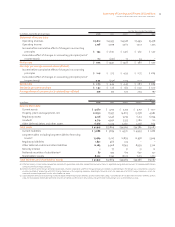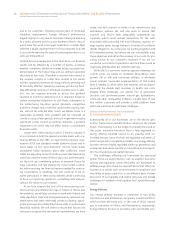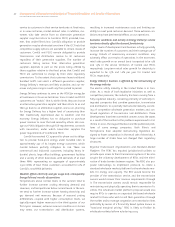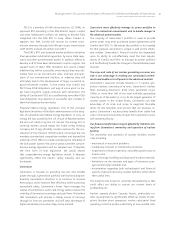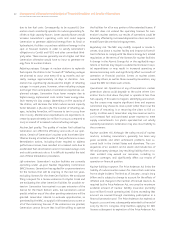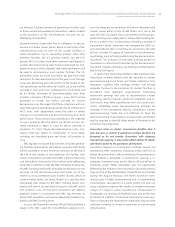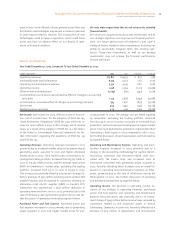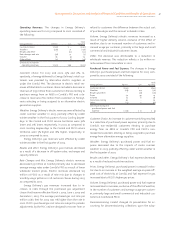ComEd 2003 Annual Report Download - page 34
Download and view the complete annual report
Please find page 34 of the 2003 ComEd annual report below. You can navigate through the pages in the report by either clicking on the pages listed below, or by using the keyword search tool below to find specific information within the annual report.32 Management’s Discussion and Analysis of Financial Condition and Results of Operations
EXELON CORPORATION AND SUBSIDIARY COMPANIES
due to low fuel costs. Consequently, to be successful, Gen-
eration must consistently operate its nuclear generating fa-
cilities at high capacity factors. Lower capacity factors would
increase Generation’s operating costs and could require
Generation to generate additional energy from its fossil or
hydroelectric facilities or purchase additional energy in the
spot or forward markets in order to satisfy Generation’s
obligations to ComEd and PECO and other committed third-
party sales. These sources generally are at a higher cost than
Generation otherwise would have to incur to generate en-
ergy from its nuclear stations.
Refueling outages. Outages at nuclear stations to replenish
fuel require the station to be “turned off.” Refueling outages
are planned to occur once every 18 to 24 months and cur-
rently average approximately 26 days in duration. Gen-
eration has significantly decreased the length of refueling
outages in recent years. However, when refueling outages
last longer than anticipated or Generation experiences un-
planned outages, Generation faces lower margins due to
higher energy replacement costs and/or lower energy sales.
Each twenty-six day outage, depending on the capacity of
the station, will decrease the total nuclear annual capacity
factor between 0.3% and 0.5%. The number of refueling out-
ages, including AmerGen, will increase to ten in 2004 from
nine in 2003. Maintenance expenditures are expected to in-
crease by approximately $20 million in 2004 as compared to
2003 as a result of increased nuclear refueling outages.
Nuclear fuel quality. The quality of nuclear fuel utilized by
Generation can affect the efficiency and costs of our oper-
ations. Certain of Generation’s nuclear units have been iden-
tified as having a limited number of fuel performance issues.
Remediation actions, including those required to address
performance issues, have resulted in increased costs due to
accelerated fuel amortization and/or increased outage costs
and could continue to do so. It is difficult to predict the total
cost of these remediation procedures.
Life extensions. Generation’s nuclear facilities are currently
operating under 40-year Nuclear Regulatory Commission
(NRC) licenses. Generation has applied for 20-year extensions
for the licenses that will be expiring in the next ten years,
excluding licenses for the AmerGen facilities. We anticipate
filing a request for a license extension for Oyster Creek and
are evaluating the other AmerGen facilities for possible ex-
tension. Generation has received a 20-year extension of the
license for the Peach Bottom units, but Generation cannot
predict whether any of the other pending extensions will be
granted. Generation intends to evaluate opportunities, as
permitted by the NRC, to apply for life extensions to some or
all of the remaining licenses. If the extensions are granted,
Generation cannot be sure that it will be willing to operate
the facilities for all or any portion of the extended license. If
the NRC does not extend the operating licenses for Gen-
eration’s nuclear stations, our results of operations could be
adversely affected by increased depreciation rates and accel-
erated future decommissioning payments.
Regulatory risk. The NRC may modify, suspend or revoke li-
censes, shut down a nuclear facility and impose civil penal-
ties for failure to comply with the Atomic Energy Act, related
regulations or the terms of the licenses for nuclear facilities.
A change in the Atomic Energy Act or the applicable regu-
lations or licenses may require a substantial increase in capi-
tal expenditures or may result in increased operating or
decommissioning costs and significantly affect our results of
operation or financial position. Events at nuclear plants
owned by others, as well as those owned by Generation, may
cause the NRC to initiate such actions.
Operational risk. Operations at any of Generation’s nuclear
generation plants could degrade to the point where Gen-
eration has to shut down the plant or operate at less than
full capacity. If this were to happen, identifying and correct-
ing the causes may require significant time and expense.
Generation may choose to close a plant rather than incur the
expense of restarting it or returning the plant to full ca-
pacity. In either event, Generation may lose revenue and in-
cur increased fuel and purchased power expense to meet
supply commitments. For plants operated but not wholly
owned by Generation, Generation may also incur liability to
the co-owners.
Nuclear accident risk. Although the safety record of nuclear
reactors, including Generation’s, generally has been very
good, accidents and other unforeseen problems have oc-
curred both in the United States and elsewhere. The con-
sequences of an accident can be severe and include loss of
life and property damage. Any resulting liability from a nu-
clear accident may exceed our resources, including in-
surance coverages, and significantly affect our results of
operation or financial position.
Nuclear liability insurance. The Price-Anderson Act limits the
liability of nuclear reactor owners for claims that could arise
from a single incident. The limit as of January 1, 2004 is $10.9
billion and is subject to change to account for the effects of
inflation and changes in the number of licensed reactors. As
required by the Price-Anderson Act, we carry the maximum
available amount of nuclear liability insurance (currently
$300 million for each operating site). Claims exceeding that
amount are covered through mandatory participation in a
financial protection pool. The Price-Anderson Act expired on
August 1, 2002 and was subsequently extended to the end of
2003 by the U.S. Congress. Only facilities applying for NRC
licenses subsequent to expiration of the Price-Anderson Act



